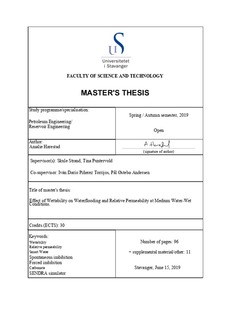| dc.contributor.advisor | Strand, Skule | |
| dc.contributor.advisor | Puntervold, Tina | |
| dc.contributor.advisor | Torrijos, Iván D. P. | |
| dc.contributor.advisor | Andersen, Pål Østebø | |
| dc.contributor.author | Harestad, Amalie | |
| dc.date.accessioned | 2019-10-02T07:59:49Z | |
| dc.date.available | 2019-10-02T07:59:49Z | |
| dc.date.issued | 2019-06-15 | |
| dc.identifier.uri | http://hdl.handle.net/11250/2619767 | |
| dc.description | Master's thesis in Petroleum Technology | nb_NO |
| dc.description.abstract | This project contributes with experimental measurement that could increase our understanding on how relative permeability is affected by wettability during an oil recovery process. Wettability has significant attention to the industry and academia, specially linked to enhanced oil recovery (EOR), where diverse mechanisms have been purposed to increase recovery by changing the wetting state of reservoir rocks, as it impacts reserves volumes and flooding performance.
In this study, two carbonate chalk material from Stevns Klint (SK) were cleaned and flooded with a crude oil with an acid number (AN) of 0.34 mgKOH/g, at ambient temperature. AN indicates the amount polar organic components (POC), POC are responsible for wettability alteration to an oil-wet state. The crude oil was displaced with a non-wetting mineral oil (M-OIL) to preserve the wetting. The wettability of the cores after oil flooding were assessed blabalbal. In order to confirm the adsorption effect and wettability, oil recovery tests (spontaneous and forced imbibition) were performed with formation water. Following the forced imbibition test, chromatographic wettability test (CWT) were performed to confirm the wettability of the core. Two strongly water-wet reference cores were used for comparing the results. Strongly water-wet cores were flooded with mineral oil, and recovery test and CWT to confirm the strongly water state. Pressure drop across the cores were logged during the forced imbibition. The pressure drop, oil recovery data and endpoint relative permeabilities was used to simulate the wetting effect on relative permeabilities. Preliminary simulation interpretation with SENDRA was performed.
The study attempts to consider the effect of wettability on waterflooding and relative permeability on chalk cores with different initial wetting states. The results showed that wettability of fractionally-wet cores were altered from very water-wet to medium water-wet, during spontaneous imbibition and chromatographic wettability tests, compared to strongly water-wet reference cores. Results from simulation, showed small differences in relative permeability for all cores. | nb_NO |
| dc.language.iso | eng | nb_NO |
| dc.publisher | University of Stavanger, Norway | nb_NO |
| dc.relation.ispartofseries | Masteroppgave/UIS-TN-IER/2019; | |
| dc.rights | Navngivelse 4.0 Internasjonal | * |
| dc.rights.uri | http://creativecommons.org/licenses/by/4.0/deed.no | * |
| dc.subject | petroleumsteknologi | nb_NO |
| dc.subject | petroleum technology | nb_NO |
| dc.subject | reservoir engineering | nb_NO |
| dc.subject | reservoir technology | nb_NO |
| dc.subject | reservoarteknologi | nb_NO |
| dc.title | Effect of Wettability on Waterflooding and Relative Rermeability at Medium Water-Wet Conditions. | nb_NO |
| dc.type | Master thesis | nb_NO |
| dc.subject.nsi | VDP::Technology: 500::Rock and petroleum disciplines: 510::Petroleum engineering: 512 | nb_NO |
| dc.source.pagenumber | 96 | nb_NO |

